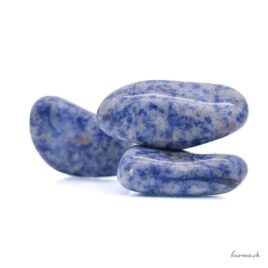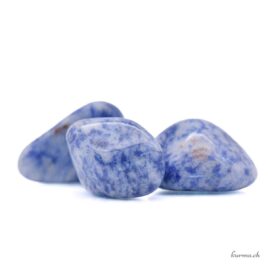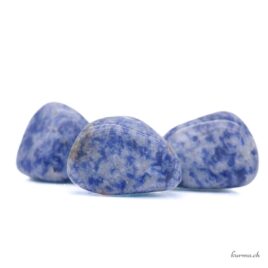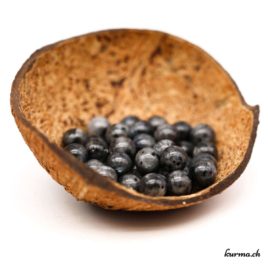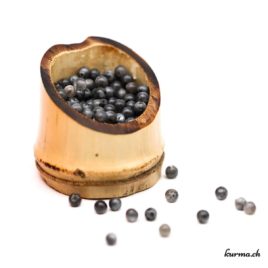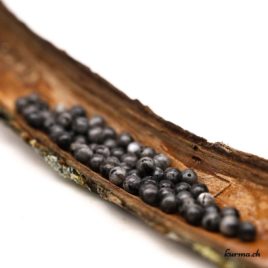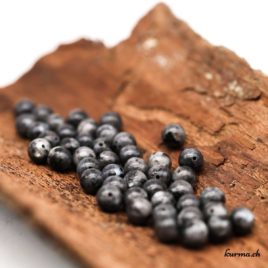Syenite
gemstones, beads of 4.5mm, 6-6.5mm, 8-8.5mm, 10-10.5mm, with Larvikite
Syenite is a beautiful plutonic magmatic rock, much like granite, except that it contains little or no quartz.
In lithotherapy, it is a stone of balance, supporting structure and anchoring.
What are the spiritual virtues of Syenite in lithotherapy?
The origins of the Syenite symbols
Syene is the ancient name of the city of Aswan in Upper Egypt, which inspired the name Syenite. Although the mineral extracted there is mainly pink granite, the geologist A.G. Werner gave it this name in the 18th century, referring to quartz-free Hornblende-bearing rocks.
It was used in ancient Egyptian art and architecture. It was the raw material for a statue of the god Amun dating from 1333-1323 BC found at Karnak.
Contemporary esotericism attributes to it energetic virtues and symbolic powers linked to anchoring, mental clarity and emotional balance.
Its meaning and benefits in lithotherapy
Syenite's properties, rich in alkaline feldspars and ferromagnesian minerals, give it a robust and vigorous earth energy in lithotherapy.
With its powerful connection to the Earth, plutonic rock supports an anchoring that reconnects you to the Earth and to a dynamic that stabilizes emotions.
Its energy, derived from its crystalline composition rich in alkaline feldspars, is said to help structure the mind, facilitating the clarity of spirit needed for concentration and rational reflection. Its symbol will be useful to those who, in times of change, need to lay solid foundations for reasoned decisions.
But its spiritual power is not only logical. Its intermediate constitution between Granite and alkaline rocks - such as Biotite and Hornblende - makes Syenite a symbol of balance between matter and spirit, concreteness and intuition.
In lithotherapy, this reconciliation of two metaphorically linked planes gives it a capacity to help balance emotions and build resilience in the face of life's turmoil. Clarifying a notion of identity that is never fixed but open to the world, it is a barrier against anxiety-provoking influences, reinforcing the will and perseverance to build a life both under the auspices of the wisdom of relative vision and the discipline of solid foundations.
What stones should Syenite be associated with?
In lithotherapy, depending on your specific needs, Syenite can be combined with complementary crystals to amplify its effects:
- Combined withsteel-gray or reddish-brown Hematite, it boosts vitality and concentration.
- in addition to the spiritual stability provided by Syenite, Labradorite, a stone of auras, can help balance intuition and rationality
- Smoky Quartz, the stone of the shadow, provides a solid anchor and energetic protection in your relationship to the world and to the unconscious, your unknown part.
Refilling and cleaning
How to purify a Syenite?
Full moon, waveform, fumigation (white sage or palo santo between 30 and 60 seconds), singing bowl, Tibetan bells or tuning fork, breath/wind, intention, temporary burial in the Earth for reconnection to one's element of origin.Care to avoid
Chemicals and extreme temperatures are not recommended.
Chakras
Root chakra (Muladhara)anchoring / stability / security and link to physical reality
Astrological signs
Capricornbrings rigor/structure
Taurus
provides stability/bonding to the material
Virgin
brings organization / clarification
Element
EarthAnchoring and deep reality
Syenite mineralogy
Syenite is a plutonic magmatic rock, holocrystalline and grainy, often gray/black, pink or purplish in color, very similar to granite, but with a low quartz content.
It's an intermediate rock between granite and alkaline rocks, mainly composed of alkaline feldspars (Orthose, Microcline), sodium plagioclase, hornblende, biotite, and accessory minerals such as apatite, magnetite, zircon and sphene.
It also occurs as Nepheline Syenite, a silica-undersaturated variant including feldspathoids such as Nepheline, Analcime and Sodalite.
It was formed in alkaline-rich geological environments, continental subduction zones or magmatic differentiation contexts.
Syenite is mined in many parts of the world, including South Africa, Egypt, Canada, Corsica, the United States, Finland, Norway (famous for its Larvikite variant) and Sweden.
Syenite's hardness ranges from 5.5 and 6 on the Mohs scale - making it a medium-to-high-hard rock. Its hardness is mainly due to alkaline feldspars (such as Orthose, with a hardness of 6 on the Mohs scale). If it contains Hornblende or Biotite, its hardness will be only slightly lower (around 5-6).
Reproduction in whole or in part of this content is prohibited. More info


